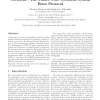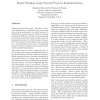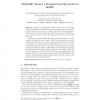132
Voted
INFOCOM
2012
IEEE
13 years 3 months ago
2012
IEEE
—This paper considers a component-level deceleration technique in BS operation, called speed-scaling, that is more conservative than entirely shutting down BSs, yet can conserve ...
147
Voted
GLOBECOM
2010
IEEE
14 years 10 months ago
2010
IEEE
Cognitive networking deals with applying cognition to the entire network protocol stack for achieving stack-wide as well as network-wide performance goals, unlike cognitive radios ...
113
Voted
JACM
2000
15 years 12 days ago
2000
A crashing network protocol is an asynchronous protocol whose memory does not survive crashes. We show that a crashing network protocol that works over unreliable links can be driv...
112
click to vote
IJNSEC
2007
15 years 16 days ago
2007
In this paper a secure error-signalling scheme for packetswitched network architectures is presented. Current solutions are based on the Internet Control Message Protocol to deliv...
96
Voted
BMCBI
2007
15 years 22 days ago
2007
Background: The Distributed Annotation System (DAS) is a network protocol for exchanging biological data. It is frequently used to share annotations of genomes and protein sequenc...
115
Voted
NSDI
2004
15 years 2 months ago
2004
Network protocols must work. The effects of protocol specification or implementation errors range from reduced performance, to security breaches, to bringing down entire networks....
111
click to vote
CIIT
2004
15 years 2 months ago
2004
Vulnerabilities arising from in-secure network protocol design and implementation present significant challenges to the network protocol community. Yet much of the focus is on sof...
135
Voted
ICTAI
1997
IEEE
15 years 4 months ago
1997
IEEE
This paper tackles the problem of analyzing the correctness and performance of a computer network protocol. Given the complexity of the problem, no currently used technique is abl...
SIGMETRICS
1997
ACM
15 years 4 months ago
1997
ACM
In this paper we present a performance study of memory reference behavior in network protocol processing, using an Internet-based protocol stack implemented in the x-kernel runnin...
89
Voted
SIGSOFT
2000
ACM
15 years 5 months ago
2000
ACM
Fuzzing is a well-known black-box approach to the security testing of applications. Fuzzing has many advantages in terms of simplicity and effectiveness over more complex, expensi...




